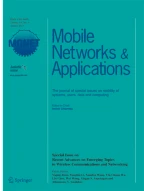Abstract
Indoor multiple target tracking is a promising research field that attracts many efforts. Traditional approaches for tackling this problem are usually model-based methods. WiFi-based tracking approaches suffer from high cost in retrieving the CSI information. Most RF signal-based methods provide a mathematical framework correlating movement in space to a link’s RSS value. Real RSS values are used to model the signal attenuation, and the distance correlation with signal attenuation is used to estimate locations. In this paper, we propose DCT, a noise-tolerant, unobtrusive and device-free tracking framework. DCT adopts density-based clustering to find the centers. We further use a linear function of mean RSS variances and target amount and FCM algorithm to adjust the number of targets and positions. The multiple particle filter (MPF) is adopted to refine the target tracking accuracy. DCT is tolerant for noise and multi-path effects, and can fast simultaneously tracking with a O(N) time complexity. The extensive experiments in trace-driven simulations and real implementations show that DCT is efficient and effective in tracking multiple target, and can achieve a high precision.
Similar content being viewed by others
References
Arulampalam MS, Maskell S, Gordon N, Clapp T (2002) A tutorial on particle filters for online nonlinear/non-gaussian bayesian tracking. Signal Processing. IEEE Transactions on 50(2):174–188
Bajaj R, Ranaweera SL, Agrawal DP (2002) Gps: location-tracking technology. Computer 35(4):92–94
Bugallo MF, Lu T, Djuric PM (2007) Target tracking by multiple particle filtering. In: Aerospace conference, 2007 IEEE, pp. 1–7. IEEE
Chintalapudi K, Padmanabha Iyer A, Padmanabhan VN (2010) Indoor localization without the pain. In: Proceedings of ACM MobiCom
Chon J, Cha H (2011) Lifemap: a smartphone-based context provider for location-based services. IEEE Pervasive Computing 10(2):58–67
Durgin GD, Rappaport TS, De Wolf DA (2002) New analytical models and probability density functions for fading in wireless communications. IEEE Transactions on Communications 50(6):1005–1015
Huang W, Xiong Y, Li XY, Lin H, Mao X, Yang P, Liu Y (2014) Shake and walk: Acoustic direction finding and fine-grained indoor localization using smartphones. In: Proceedings of IEEE INFOCOM
Kaltiokallio O, Bocca M, Patwari N (2014) A fade level-based spatial model for radio tomographic imaging. IEEE Trans Mob Comput 13(6):1159–1172
Khaledi M, Kasera SK, Patwari N, Bocca M (2014) Energy efficient radio tomographic imaging. In: Proceedings of IEEE SECON
Kotaru M, Joshi K, Bharadia D, Katti S (2015) Spotfi: Decimeter level localization using wifi. In: Proceedings of ACM SIGCOMM. ACM
Kuo YS, Pannuto P, Hsiao KJ, Dutta P (2014) Luxapose: Indoor positioning with mobile phones and visible light. In: Proceedings of ACM MobiCom
Nannuru S, Li Y, Zeng Y, Coates M, Yang B (2013) Radio-frequency tomography for passive indoor multitarget tracking. IEEE Trans Mob Comput 12(12):2322–2333
Ni LM, Liu Y, Lau YC, Patil AP (2004) Landmarc: indoor location sensing using active rfid. Wireless networks 10(6):701–710
Pal NR, Bezdek JC (1995) On cluster validity for the fuzzy c-means model. IEEE Trans Fuzzy Syst 3 (3):370–379
Patwari N, Wilson J (2009) People-sensing spatial characteristics of rf sensor networks. arXiv preprint 0911.1972
Patwari N, Wilson J (2010) Rf sensor networks for device-free localization: Measurements, models, and algorithms. Proc IEEE 98(11):1961–1973
Pu Q, Gupta S, Gollakota S, Patel S (2013) Whole-home gesture recognition using wireless signals. In: Proceedings of ACM MobiCom
Rodriguez A, Laio A (2014) Clustering by fast search and find of density peaks. Science 344(6191):1492–1496
Thouin F, Nannuru S, Coates M (2011) Multi-target tracking for measurement models with additive contributions. In: Proceedings of IEEE FUSION
Vasisht D, Kumar S, Katabi D (2016) Decimeter-level localization with a single wifi access point. In: Proceedings of USENIX NSDI. USENIX Association
Wang Y, Liu J, Chen Y, Gruteser M, Yang J, Liu H (2014) E-eyes: device-free location-oriented activity identification using fine-grained wifi signatures. In: Proceedings of ACM MobiCom
Wei B, Varshney A, Patwari N, Hu W, Voigt T, Chou CT (2015) drti: directional radio tomographic imaging. In: Proceedings of ACM IPSN
Wilson J, Patwari N (2010) Radio tomographic imaging with wireless networks. IEEE Trans Mob Comput 9(5):621–632
Wilson J, Patwari N (2011) See-through walls: Motion tracking using variance-based radio tomography networks. IEEE Trans Mob Comput 10(5):612–621
Xi W, Zhao J, Li XY, Zhao K, Tang S, Liu X, Jiang Z (2014) Electronic frog eye: Counting crowd using wifi. In: Proceedings of IEEE INFOCOM
Xiong J, Jamieson K (2013) Arraytrack: a fine-grained indoor location system. In: Proceedings of USENIX NSDI
Yang L, Chen Y, Li XY, Xiao C, Li M, Liu Y (2014) Tagoram: real-time tracking of mobile rfid tags to high precision using cots devices. In: Proceedings of ACM MobiCom
Youssef M, Mah M, Agrawala A (2007) Challenges: device-free passive localization for wireless environments. In: Proceedings of ACM MobiCom
Zhao Y, Patwari N, Phillips JM, Venkatasubramanian S (2013) Radio tomographic imaging and tracking of stationary and moving people via kernel distance. In: Proceedings of ACM IPSN
Zhu X, Li Q, Chen G (2013) Apt: Accurate outdoor pedestrian tracking with smartphones. In: Proceedings of IEEE INFOCOM
Acknowledgment
This paper is supported by National Natural Science Foundation of China (No. 61502374, 61802291, 61702391 and 61902236), National Key Research and Development Project (No. 2019YFB1406400), China Postdoctoral Science Foundation (No. BX20180235), and the Fundamental Research Funds for Central Universities (No. JB190304).
Author information
Authors and Affiliations
Corresponding author
Additional information
Publisher’s Note
Springer Nature remains neutral with regard to jurisdictional claims in published maps and institutional affiliations.
Rights and permissions
About this article
Cite this article
Li, R., Jiang, Z., Xu, Y. et al. Device-Free Indoor Multi-target Tracking in Mobile Environment. Mobile Netw Appl 25, 1195–1207 (2020). https://doi.org/10.1007/s11036-020-01540-4
Published:
Issue Date:
DOI: https://doi.org/10.1007/s11036-020-01540-4
